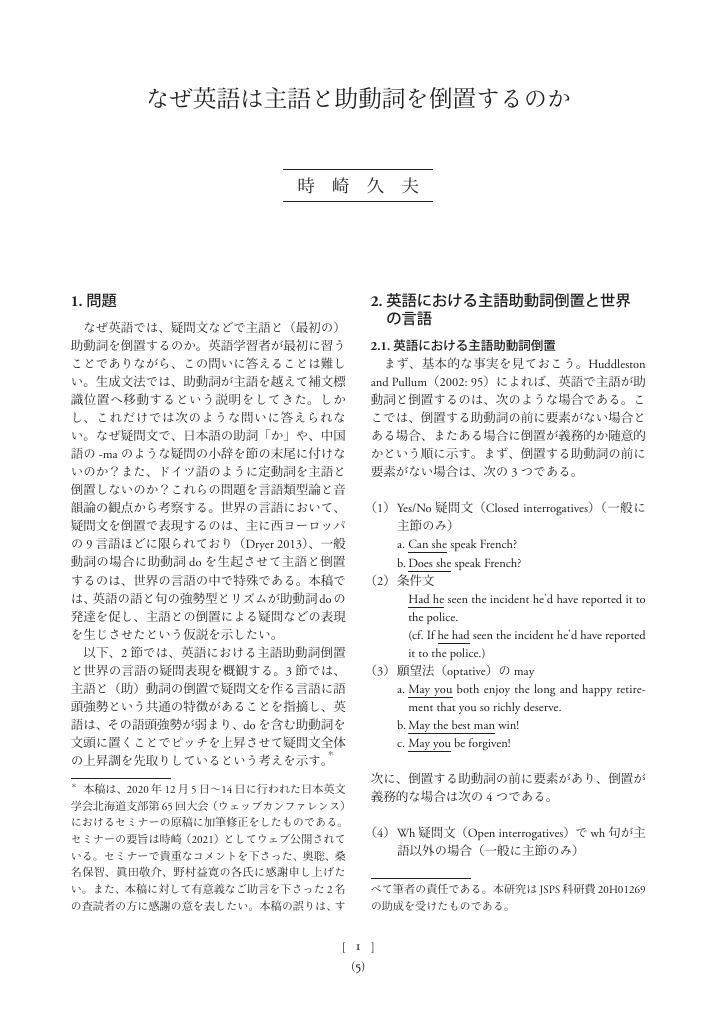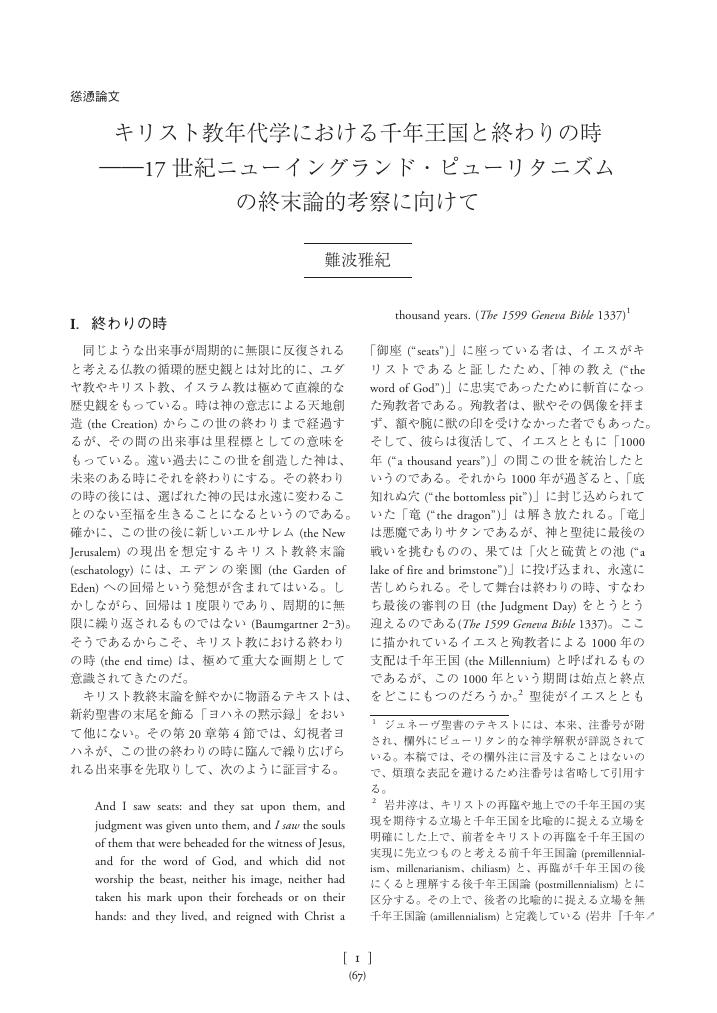- 著者
- 藤野 功一
- 出版者
- 一般財団法人 日本英文学会
- 雑誌
- 英文学研究 支部統合号 (ISSN:18837115)
- 巻号頁・発行日
- vol.12, pp.311-321, 2019 (Released:2020-12-05)
7 0 0 0 OA なぜ英語は主語と助動詞を倒置するのか
- 著者
- 時崎 久夫
- 出版者
- 一般財団法人 日本英文学会
- 雑誌
- 英文学研究 支部統合号 (ISSN:18837115)
- 巻号頁・発行日
- vol.14, pp.5-15, 2022 (Released:2022-02-13)
- 著者
- 高橋 愛
- 出版者
- 一般財団法人 日本英文学会
- 雑誌
- 英文学研究 支部統合号 (ISSN:18837115)
- 巻号頁・発行日
- vol.7, pp.229-236, 2015
Moby-Dick has been considered to be the most masculine of Herman Melville's novels. However, few studies have extensively considered the masculinity of those on board the Pequod despite the possibility that Melville had worked hard to express masculinities that deviated from the norms of American society in the nineteenth century. This paper discusses Queequeg, a harpooner from the South Seas, as a character onto whom Melville projected a facet of his multiple ideas of masculinity, by examining his body and his behaviors. First, Queequeg's race and ethnicity are ambiguous, though he is introduced as a Pacific Islander. His tattooed body characterizes him as non-white, but at the same time he transgresses the color line with his phrenologically excellent skull. His tattoos do not reveal any ethic characteristics, though it is said that he is based on a real Maori chief. Additionally, Queequeg's sexuality and gender are also ambiguous. He has a cordial friendship with Ishmale, a common sailor and the narrator of the novel. However, their friendship often seems too sensual to presume that they are just friends: Queequeg caresses his friend many times and his actions anticipate the homoerotic ecstasy that Ishmael experiences later. There also seems to be indications that Queequeg is transgender: for instance, his affectionate huging of Ishmael and his rescue of Tashtego, another harpooner. Given these points, Queequeg seems to be portrayed as an amorphous man who transgresses the boundaries of race, ethnicity, sexuality, and gender. It is possible that his amorphous self is a projected image of what Melville regards as masculine.
5 0 0 0 OA 英語縮約関係節の構造について
- 著者
- 鈴木 達也
- 出版者
- 一般財団法人 日本英文学会
- 雑誌
- 英文学研究 支部統合号 (ISSN:18837115)
- 巻号頁・発行日
- vol.10, pp.139, 2018 (Released:2019-02-16)
- 著者
- 難波 雅紀
- 出版者
- 一般財団法人 日本英文学会
- 雑誌
- 英文学研究 支部統合号 (ISSN:18837115)
- 巻号頁・発行日
- vol.9, pp.67-77, 2017 (Released:2017-05-02)
3 0 0 0 OA 感染症の時代に読み直す『ロミオとジュリエット』
- 著者
- 鶴田 学
- 出版者
- 一般財団法人 日本英文学会
- 雑誌
- 英文学研究 支部統合号 (ISSN:18837115)
- 巻号頁・発行日
- vol.14, pp.231-239, 2022 (Released:2022-02-14)
3 0 0 0 OA 語られなかったもう一つのレズビアン・プロット――サラ・ウォーターズの『アフィニティ』
- 著者
- 平林 美都子
- 出版者
- 一般財団法人 日本英文学会
- 雑誌
- 英文学研究 支部統合号 (ISSN:18837115)
- 巻号頁・発行日
- vol.9, pp.115-122, 2017 (Released:2017-05-02)
- 著者
- 堀 智弘
- 出版者
- 一般財団法人 日本英文学会
- 雑誌
- 英文学研究 支部統合号 (ISSN:18837115)
- 巻号頁・発行日
- vol.11, pp.63-70, 2018 (Released:2019-02-07)
3 0 0 0 感染症の時代に読み直す『ロミオとジュリエット』
- 著者
- 鶴田 学
- 出版者
- 一般財団法人 日本英文学会
- 雑誌
- 英文学研究 支部統合号 (ISSN:18837115)
- 巻号頁・発行日
- vol.14, pp.231-239, 2022
3 0 0 0 OA 女性と死をめぐって : 十九世紀イギリス女性詩人と作品(北海道英語英文学)
- 著者
- 滝口 智子
- 出版者
- 一般財団法人 日本英文学会
- 雑誌
- 英文学研究 支部統合号 (ISSN:18837115)
- 巻号頁・発行日
- vol.6, pp.17-24, 2014-01-20 (Released:2017-06-16)
- 著者
- 石田 由希
- 出版者
- 一般財団法人 日本英文学会
- 雑誌
- 英文学研究 支部統合号 (ISSN:18837115)
- 巻号頁・発行日
- vol.1, pp.381-393, 2009-01-10 (Released:2017-06-16)
- 著者
- 板倉 宏予
- 出版者
- 一般財団法人 日本英文学会
- 雑誌
- 英文学研究 支部統合号 (ISSN:18837115)
- 巻号頁・発行日
- vol.9, pp.15-26, 2017 (Released:2017-05-02)
- 著者
- 下楠 昌哉
- 出版者
- 一般財団法人 日本英文学会
- 雑誌
- 英文学研究 支部統合号 (ISSN:18837115)
- 巻号頁・発行日
- vol.11, pp.251-254, 2018 (Released:2019-02-07)
2 0 0 0 「幻想的な黙想」:ブレイクの古事物愛好主義的想像力
- 著者
- 鈴木 雅之
- 出版者
- 一般財団法人 日本英文学会
- 雑誌
- 英文学研究 支部統合号 (ISSN:18837115)
- 巻号頁・発行日
- vol.14, pp.139-147, 2022
- 著者
- 山口 和彦
- 出版者
- 一般財団法人 日本英文学会
- 雑誌
- 英文学研究 支部統合号 (ISSN:18837115)
- 巻号頁・発行日
- vol.8, pp.67-76, 2016-01-20 (Released:2017-06-16)
Cormac McCarthy's Blood Meridian, or the Evening Redness in the West has been highly evaluated as a counter-history of the borderland, or as an epic novel. A number of critics, however, have pointed out its lack of ethical substance due to its abundant descriptions of violence, blood, and death. This essay examines the thematics of violence, and reinterprets BM as a work of fiction that explores the whereabouts and possibility of ethics in the postmodern and in the posthuman. The kid's characterization as a mother-killer is associated with the violence of American historiography, reflecting the rhetoric of America's expansion as biological development. It, in turn, defies the conventions of the Western-Bildungsroman genre: the building of American character through frontier experiences. Thus, BM foregrounds ontological problems of human existence and free will in the apocalyptic borderland. The desert in BM functions as a topos in which the judge practices his hyper-rational, hyper-nihilistic violence, which relativizes every system of values to the single purpose of life: "war," that is, "the truest form of divination." The kid, the judge's biggest rival, rejects being a subject of the "war," and, as a result, is cannibalized by the judge himself (not as a sacrifice for the common good or belief). His death, however, is presented as the unrepresentable, which demonstrates that this death itself is not usurped by the judge, who attempts to be the suzerain of the earth. The biggest dilemma the story presents is the kid's rejection of opportunities to kill the judge by exercising his own violent nature. This, paradoxically, leads to the possibility of a counter-ethics that continues to reject the judge's philosophy of violence. The counter-ethics (in the posthuman), in this sense, might be represented as one always already in a germinal stage, as shown in the epilogue.
- 著者
- 沢田 知香子
- 出版者
- 一般財団法人 日本英文学会
- 雑誌
- 英文学研究 支部統合号 (ISSN:18837115)
- 巻号頁・発行日
- vol.7, pp.167-174, 2015
Marina Warner tells us that "the fairytale transformations of Cinders into princess represnt what a girl has to do to stay alive." When a girl transforms, themes of female survival and construction of self vividly emerge. Moreover, women's situation and problems present themselves in various guises. Focusing on contemporary fiction which deals with transformations of women, this paper examines images of women and explores new ways and possibilities for a woman to tell her story. This paper first looks into Angela Carter's heroines who transform themselves into predatory animals and survive, and considers the influence of Carter and her rebellious heroines on contemporary retellings of fairy tales. It will then examine Ursula Le Guin's "Daddy's Big Girl" to illustrate women's narrative strategy and Aimee Bender's "The Color Master" based on "The Donkey-skin" as a story of a woman's attempt to capture true colors and to weave her own text/textiles. Both stories are discussed, focusing on other important and relevant themes such as father-daughter relationship, mother-daughter relationship and women's body. These analyses unveil the guise of an innocent girl, revealing a defiant narrative and female figure.
2 0 0 0 OA 生成文法における自律意味論の必要性
- 著者
- 大室 剛志
- 出版者
- 一般財団法人 日本英文学会
- 雑誌
- 英文学研究 支部統合号 (ISSN:18837115)
- 巻号頁・発行日
- vol.11, pp.179-186, 2018 (Released:2019-02-07)
- 著者
- 岡裏 浩美
- 出版者
- 一般財団法人 日本英文学会
- 雑誌
- 英文学研究 支部統合号 (ISSN:18837115)
- 巻号頁・発行日
- vol.3, pp.517-530, 2011-01-20 (Released:2017-06-16)
1 0 0 0 OA ベンジャミン・フランクリンと知のコミュニティ――フィラデルフィア図書館会社を中心に
- 著者
- 竹腰 佳誉子
- 出版者
- 一般財団法人 日本英文学会
- 雑誌
- 英文学研究 支部統合号 (ISSN:18837115)
- 巻号頁・発行日
- vol.10, pp.129, 2018 (Released:2019-02-16)
- 著者
- 山本 真由美
- 出版者
- 一般財団法人 日本英文学会
- 雑誌
- 英文学研究 支部統合号 (ISSN:18837115)
- 巻号頁・発行日
- vol.12, pp.155-163, 2019 (Released:2020-12-05)













